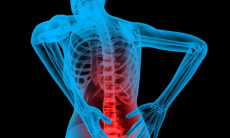

The sensation of Pain and Pain Pathways
Pain is described as an ‘unpleasant sensory or emotional experience associated with real or potential tissue damage.’ There are two components to the pain pathway. Firstly, where afferent fibres are activated by noxious stimuli and send sensory information regarding nociception to the central nervous system. Secondly, a pain sensation is generated via integration of sensory information.
There are two types of pain: fast and slow. Fast pain uses Aδ (delta) fibres to send short, sharp, pricking, well-localised stimuli. These fibres are myelinated for fast conduction via saltatory conduction. For the fast pain pathway, there are mechanosensitive receptors and temperature sensitive receptors. Slow pain pathways use C fibres. They are unmyelinated and generate long lasting pain. For slow pain there are mechanosensitive, temperature and chemical sensitive receptors. The neurotransmitter sent along these pathways is glutamate and neuropeptides such as substance P.
Why have two different types of pain?
Well think about it this way. If we touch a burning hot radiator, we need a fast pain signal to be sent to get us to immediately react and remove our hands. In this case it would be a reflex response “ouch this is burning hot, let me remove my hand.” We need the signal to be fast, so we don’t spend any longer burning our hands, we need it to be well localised, so we know exactly where the pain is coming from and exactly where our bodies need to react. We also need the sharp, this tells us not to do this again. If we don’t get this pain sensation then we can continue to do things that are potentially damaging. This can happen in certain illnesses, for example in leprosy. Additionally, certain drugs can alter our perception of pain.
The pain pathway goes from the skin to the thalamus, it is called the spinothalamic tract. Descending pathways can work to alter the perception of pain. The descending pathway begins with periaqueductal gray and goes down to the spinal cord. Tissue damage sensed by sensory receptors sends a signal to the brain, the brain generates a pain sensation. The brain can also generate pain associated with pain, for example, lack of motivation, self- esteem or depression.
The gate theory of pain suggests that a distracting stimulus can stop us from feeling a pain sensation. Remember a time when you cut your finger and your mum or dad kissed it better? Well there is actually some reasoning behind this. It is believed that a distracting stimulus, for example rubbing a part of the body, sends a signal and activates interneurons neurons. These inhibitory interneurons block the pain stimuli from reaching the brain so the pain sensation cannot be generated. Of course, this is only to an extent, I’m sure if you are giving birth, a little tickling of the hand is not going to make you feel better!
image-https://medicalxpress.com/news/2018-03-pain-wrong.html

0 Comment:
Be the first one to comment on this article.